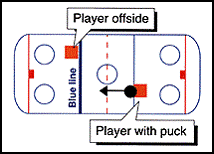|
Rules A Beginners Guide to Ice Hockey - For a more detailed guide and information on kit and finding a local team click here. The Basics:
Ice Hockey is one of the fastest growing spectator sports in the UK. Each game consists of 3 x 20 minute periods, and there is a 15-minute break between the periods. Each team can have a maximum squad of 18 players, with 2 'apprentices'. Only 6 players from each team can be on the ice at any time, however players can swap as often as they want (usually every few minutes). Players and the puck can go anywhere on and over the ice surface. The puck is deemed out of play if it goes over the glass or if the referee loses sight of it, usually behind a player's skate against the boards. When the referee stops play, the timekeeper in turn stops the clock. Play, and the clock, starts again with a face off, the position of the face off depends on why/where play stopped. The clock counts down from 20:00 to 00:00 for each of the three periods of the game. A goal is scored when the whole of the puck completely crosses the goal line. The goal judge who sits behind the goal puts on a red light to signal the goal but the referee signals whether it is a goal, by pointing to the goal, or a washout by spreading his arms wide. A goal can be scored if the puck is deflected off another player or a skate, but cannot be deliberately kicked in, or deflected off a referee or linesman. Physical contact is allowed between players contesting for the puck. Rough contact, which could cause injury, is covered by various rules. There are several lines on an ice hockey rink, and these are either Red or Blue. The red line across the centre divides the ice into two halves. The blue lines divide the ice into thirds or zones. The centre zone is the neutral zone; the others are the attacking zone and the defensive zone. The semi-circle around the goal is the crease; attacking players cannot score if they are in the crease deliberately. HOCKEY'S TWO MAIN RULES:  Offside  Icing |
|
THE PLAYERS
Netminder: The netminders primary task is simple - keep the puck out of his own net. Offensively, he may start his team down the ice with a pass, but seldom does he leave the net he guards. Defence: These players try to stop the incoming play at their own blue line. They try a break-up passes, block shots, cover opposing boards and clear the puck from in front of their own goal. Offensively, they get the puck to their forwards and follow the play to the attacking zone, positioning themselves just inside their opponents blue line at the "points". Centre: The striker on the ice, the centre leads the attack by carrying the puck on offence. On defence, he tries to disrupt a play before it gets on his team's side of the ice. Wings: The Wings team-up with the Center, on the attack, to set up shots on goal. Defensively, they attempt to break-up plays by their counterparts and upset the shot attempts. THE OFFICIALS
Referee: Black and White striped shirt with Orange armbands. The referee supervises the game, calls the penalties, determines goals and handles face-offs at centre ice to start each period. Linesman: Black and White striped shirt. Two are used. They call offside, offside passing, icing and handle all face-offs not occurring in centre ice. They do not call penalties but can recommend to the referee that a penalty be called. Goal Judges: One sits off-ice behind each goal and indicates whether a goal has been scored by turning on a red light just above their station. The referee can ask his advice on disputed goals, but the referee has final authority and can overrule the goal judge. PENALTIES
Players who break the rules may be penalised, they are sent to the penalty box for 2 or more minutes, leaving their team short of a player. The other team then has a power play. If they score within the 2 minutes, the player in the penalty box comes out. Once the play resumes, the game announcer will state the player's number and name, the length of the penalty, the name of the penalty and the game time when it occurred. A team plays shorthanded when one or more of its players are charged with a penalty (Powerplay). However, no team is forced to play more than two players below full strength (6), at any time. When a third penalty is assessed to the same team, the penalty is suspended until the first penalty expires. When the penalty is called on the goalie a teammate serves his time in the penalty box. Minor Penalty: (Two minutes). Called for tripping, hooking, spearing, slashing, charging, roughing, holding, elbowing and boarding. Major Penalty: (Five minutes). Called for fighting or when minor penalties are committed with the deliberate attempt to injure. Major penalties for slashing, spearing, high sticking, elbowing, butt ending and crosschecking carry automatic game misconducts. Misconduct: (Ten minutes). Called for various forms of unsportsmanlike behaviour or when a player incurs a second major penalty in a game. This is a penalty against an individual and not a team, so a substitute is permitted. Penalty Shot: A free shot, unopposed, except the goalie, given to a player who is illegally impeded from behind while he has possession of the puck with no opponent between him and the goalie, except the goalie. A team, which commits the offence, is not penalized beyond a penalty shot, whether it succeeds or not. Delayed Penalty: Whistle is delayed until the penalized team regains possession of the puck. |
